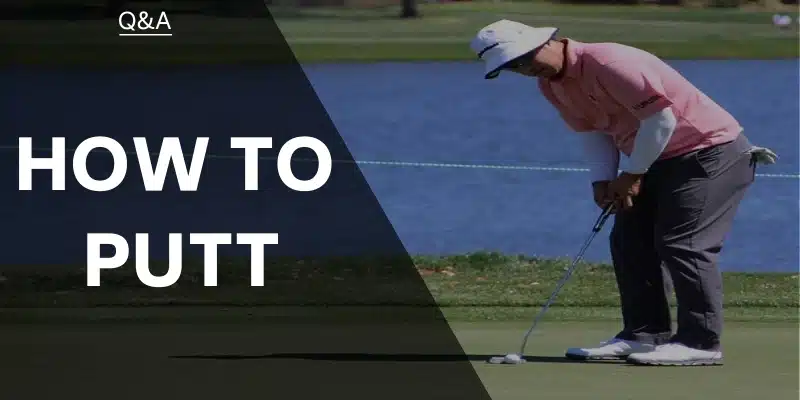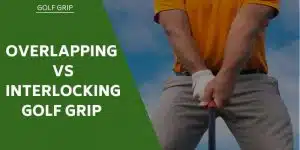In this post, we will look at the difference between strong vs weak vs neutral golf grip. These tips will enable you to identify if you have the best grip for your swing and how to make adjustments for optimal performance.
How you grip your club has a direct impact on the result of your shot. If your grip does not compliment your swing, it can cause you to hook or slice your strikes.
Different Types of Grips
There are three main types of grips that golfers employ in their game. Strong, weak, and neutral grips. A Strong or inter-locking grip sets you up to draw the ball, as the position of the clubhead requires you to swing from inside to out to hit the ball squarely at impact. If your rhythm is off, it can cause you to strike a duck-hook rather than a draw.
Weak grips, also known as an overlapping grip, help to promote a fade as you swing from out to in. Finally, a neutral grip is possibly the easiest to use, as you grip the club like you would a baseball bat.
Having all ten fingers on the club helps beginners to generate more power and ultimately distance. However, since your hands operate independently of one another, you may experience the odd hook or slice when your swing is off-kilter.
Interlocking (Strong Grip)
Pros
- The grip helps to hit more consistent shots from right to left
- Keeps the club secure on your backswing and follow-through
- Enables you to optimize your clubhead speed for increased distance
Cons
- Swinging inside-outside puts you at risk of hooking shots
What is an Interlocking Grip?
An interlocking setup is the strongest of the three grip types. Golfers with this approach will grip the club from underneath with their strongest hand. If you are a right-hander, then your right thumb will be facing slightly to the same side of the clubhead.
The fist on that same hand will likely face directly to the ground. The same goes for left-handers. While this gives you the tightest grip on your club. It can cause players with slower hip rotation to pull the ball.
The reason for the draw bias shots is because most players will swing from in to out. This is in an attempt to get the clubhead square at impact. If you are struggling with a severe slice, you may want to test out an interlocking grip to see if it helps you hit straighter or slightly left.
How do you Make an Interlocking Grip?
Achieving an interlocked grip is a simple process. I am going to give an example for right-handers, so if you are a left-handed player, simply do the opposite.
Grip the club with your and ensure that your fist is facing upwards. Next, grip the club with your right hand from underneath, and slide your pinky between your index and middle fingers. Then, rest it on the back of the former.
Finally, this grip should cause the thumb on your right hand to be angled to the right of the clubhead. Just like that, you have an interlocking grip and will be able to feel that the club is secure in your hands.
Who Should Consider Strengthening Their Grip?
If you are the victim of an uncontrollable slice or tend to push your shots at the best of times. It may benefit you to strengthen your grip and promote a consistent right to left shape.
Overlapping or Vardon Grip (Weak)
Pros
- It helps players compensate for a hook
- The grip promotes swing uniformity with both hands locked together
Cons
- Results in less distance than a strong, or neutral grip
- May cause you to push or slice shots
What is an Overlapping Grip?
The Vardon grip is the most commonly used grip by amateurs and professionals. Similar to the interlocking grip. The overlap sees your pinky wrap over the bottom of your index finger instead of fitting between your index and middle finger.
The name of the grip originated from the most successful British Open golfer in history, Harry Vardon. Vardon was a superstar at the backend of the 1800s and into the early 1990s. During his tenure, he conjured up six Open wins, more than any other player in history. It was he who pioneered the overlapping grip which still reigns supreme in the 21st Century.
The overlapping grip results in the least amount of fingers touching the club. Out of the three grips. It results in a slightly weaker grip that can cause a slice or a pushed shot if your clubhead is not square at impact.
While a stronger grip causes you to swing from inside-out, the overlapping grip prompts you to swing from outside-in.
How do you Make an Overlapping Grip?
If you are a right-hander, place your left hand a few inches down from the top of your club. Then grip the handle with your right hand and wrap your pinky finger over the bottom of your index finger. You will be able to see more knuckles on your right hand than with an interlocking grip.
Opposite to the interlocking grip, this setup will result in your right-hand thumb facing to the left of the clubhead.
Who Should Consider Weakening Their Grip?
Those of you who struggle with a hook or intense draw may find that switching to a weakened grip can help compensate for your hook.
10 Fingers or Baseball Grip (Neutral)
Pros
- It helps you gain more distance over a Vardon grip.
- Enables a more powerful launch
- Comfortable grip for beginners to use given its similarity to a baseball grip
- The additional power from the grip helps to achieve a higher Coefficient of Restitution for amplified energy transfer from club to ball at impact.
Cons
- Hands are not connected, risking imbalance during your swing that leads to slice and hook shots
- May cause you to push or slice shots
The 10-finger golf grip is a neutral setup and is an easy grip to start playing golf with. There is no interlocking or overlapping as all ten fingers touch the club at the same time. That enables you to transfer maximum power from the clubface to the ball at impact.
This grip further enables you to rotate your wrists to gain optimal clubhead speed on your downswing for longer carry. Coaches often recommend this to beginners or players who generate less clubhead speed. The baseball grip offers you greater leverage to generate speed through your swing and achieve optimal carry and total distance.
What is a Neutral Grip?
A neutral grip is most likely to be used by beginners, children, or players with slower clubhead speeds, and me. Its similarity to a baseball grip makes it an easy setup for newbies to learn. The neutral grip has also earned the name the ten-finger grip. The reason for this is that all ten of your fingers touch the grip of your club.
The neutral grip promotes a straighter ball flight than the interlocking and overlapping options. However, this disconnection of your hands can lead to an imbalance in your swing resulting in pushed and pulled shots.
The additional fingers on your grip help you to generate sufficient power to boost your C.O.R, resulting in an increased transfer of energy from the clubhead to the ball at impact. In turn, this helps you to generate more distance than a Vardon grip.
How do you Make a Neutral Grip?
If you are a right-hander, grip the club with your left hand, and position your thumb running down the club, slightly right of center. Next, cover your left thumb with all the fingers on your right hand, minus the thumb. Your right thumb should run down the grip and be facing right of center.
Who Should Consider Using A Neutral Grip?
A neutral grip suits beginners, children, and slow swingers that are looking for more energy transfer at impact. That said, I use a neutral grip and have done it for most of my career. It has always felt more comfortable and natural than any other grip.
I also hit my driver through to wedges longer with this grip than the others, and therefore it never made sense to change it.
I would also recommend considering the ten-finger grip if you are looking for straighter ball flight.
Alternative Golf Grip
Back-Handed Grip (Sewsunker grip)
The Sewsunker grip is one that you have likely never seen somebody use. It was popularized by a South African golfer named Sewsunker “Papwa” Sewgolum. Sewgolum rose to fame in the 1960s, winning tournaments that comprised Harold Henning and Gary Player. He also won the Dutch Open three times in a row between 1960 and 1963 and played in the British Open.
Sadly, in 1965 the Apartheid government banned him from competing in local tournaments and revoked his passport. As a result, he was unable to play golf competitively again.
You can use the back-handed grip in an interlocking, overlapping, and baseball grip setup. If you are right-handed, you place your right hand at the top of the grip and then bring your left-hand underneath.
Finally, set up for your preferred grip, following the steps mentioned above, and swing.
One of the caddies at my local course has a back-handed grip and plays off a 2 handicap. He advised using the grip whenever I practice putting, as you can feel your stroke more. It helps you to judge the speed of putts and achieve a more consistent stroke.
What Grip Should You Use?
To avoid making the same mistake that my high school golf coach did. I will never recommend using a specific grip. The reason for that is because there is no one size fits all approach.
The coach in question changed my grip from the neutral ten-finger set up to an overlapping grip, and it was a disaster. I went back to my baseball grip, and it still works for me.
So, the moral of the story is, use what works for you. Those of you who are consistently slicing or hooking the ball. Then the tips provided above will help you try out alternative options. As a man of data, I highly recommend using a launch monitor during these tests to determine which grip delivers the best results for you.
Read more: Golf Grip Size Chart
Conclusion on Strong vs Weak vs Neutral Grips
While many will have their own opinions on what to use, but there are many ways to get the job done. After assessing strong vs weak vs neutral grips, it is evident that no one grip is superior.
It depends on how you swing a club and what feels the most comfortable. Papwa Sewgolum won tournaments gripping the club the wrong way around. While Tiger and Jack Nicklaus dominated with interlocking grips and the majority of golfers use the Vardon grip.
Now that you know about the types of golf grips. Expand your knowledge and learn more about the mechanics of swinging a golf club.
Nick is the founder of GolfSpan and an avid golfer. He's not quite a pro but has over 15 years of experience playing and coaching golfers worldwide. His mission is to bring the golfing community a better experience when it comes to choosing the right golf gear and finding the right setup for your game.






